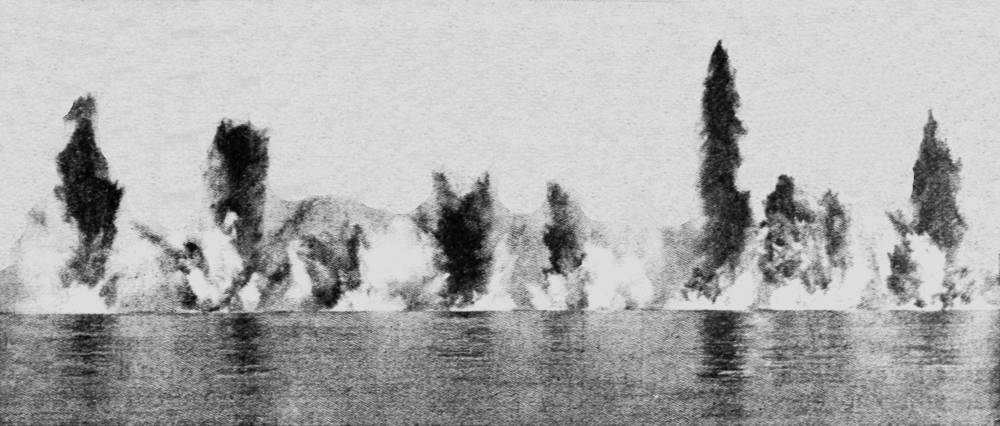The Making of a Submarine Mine
By John Randolph Rexford

A battery of mines electrically exploded. Here is a fiercely graphic illustration of the destructive power which is contained in the comparatively small globe or cylinder of steel whose sowing abroad in the sea is the first duty of the navy and coast defense when war breaks
ORIGINALLY all forms of apparatus designed to explode under water to destroy ships were called torpedoes, but this term is now applied only to the well-known naval weapon. Submarine mines may be divided into three groups:
1. Buoyant mines having a constant depth of immersion.
2. Ground mines which are used in shallow waters and rest on the bottom.
3. Floating mines.
The mines belonging to the first and second groups may be exploded either from land by an electric current or by automatic contact with a ship.
Electrically controlled mines are employed only for the protection of harbors and channels and may be divided into two classes: those which are entirely and those which are partially controlled from land. A mine consists generally of two perfectly watertight metal casings made of suitable shape. One of them is hollow and is intended to act as a float to maintain the mine at the required depth below the surface, while the other one is filled with the charge, which may be guncotton, trinitrotoluene or any other suitable explosive, and the detonator for firing the charge.
In coast defense work where electric control is employed, mines are anchored permanently in suitable positions, where hostile vessels are likely to pass over them, and are connected by means of electric cables to the shore. Where mines are entirely controlled from shore, an observer on land can fire any mine or groups of mines by closing the electric circuit the moment his optical instruments inform him that the enemy's ship is over a mine.
Firing an Electrical Mine
Mines which are partially controlled from land are anchored only a few feet below the surface of the water. When a ship strikes such a mine an electric contact is made which sends a signal to the shore station. The observer can then decide whether to fire the mine or not. An advantage of electrically controlled mines is that neutral ships can be allowed to pass over such mine fields in perfect safety. The use of such mines has, however, been considerably reduced, chiefly because salt water is one of the greatest enemies of electrical apparatus and makes it very difficult to maintain the electrical connections with the mine, and also because the permanent location
21
